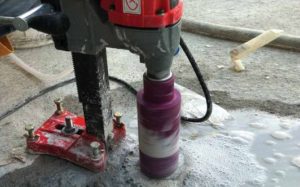Restoration of Holes Left Behind by Concrete Coring
Concrete Coring Explained

Concrete coring also involves the skill of drilling and cutting neat holes in any concrete surface — with diameters ranging from 12mm to 2 meters.
In order to drill or cut neat holes in any concrete surface, sophisticated equipment like core drills are required. Nowadays, this type of equipment is the most common due to its effectiveness and ease of handling despite its high upfront cost. On the contrary, conventional equipment such as concrete drills and grinders are still in use.
Problems with Concrete Coring
Though concrete coring is a safe and acceptable process of drilling holes in any concrete surface, the problem arises when holes are left behind without restoring it. More so if holes are located in beams, columns, and footings.
In one of our many structural inspections, we observed that some concrete core holes are covered with a variety of aesthetic material that suits the surrounding architectural look — a clever way of hiding it in plain sight and not attracting unwanted attention.
Not only it’s unethical to purposely leave holes within a concrete, it can also be a source of weak spot where cracks can develop — potentially ending up in even more costly repairs.
Having said that, Affordable Structural Builders has formulated a way of restoring any type of concrete core holes. Here is our guide in restoring concrete core holes to its original state.
Restoring Concrete Core Holes
Step 1: Chip-off loose and weak concrete inside the concrete core hole.
Using your chipping gun, remove unwanted materials all throughout the section thoroughly. Make sure that there are no weak or loose parts left.
Step 2: Drill holes inside the concrete core hole intended for rebar dowels.
Depending on the size and accessibility of the core hole, the angle of drill will vary. If the concrete drill can’t fit through to execute a normal horizontal drill, drill at an angle — ideally at 45°. The rebar dowels will be fabricated accordingly to match this configuration. Otherwise, drill normally.
Step 3: Clean and apply structural epoxy at the drilled holes.
Step 4: Insert rebar dowels in a mesh type configuration then cure for approximately 1 hour or more.
Step 5: Install formworks accordingly.
Formworks should be leak free at the joints, ideally from plywood material so that it can be easily fixed in place using concrete nails.
Step 6: Prepare non-shrink grout.
Following the manufacturer’s recommendation, make sure that the materials used has stronger compressive strength than that of the original concrete.
Step 7: Finish the new surface using stainless steel trowel.
Smoothen the surface and even out bumps and creases.
Step 8: Cure for 7 days then strip formworks.
Contact us for free quotes. Affordable Structural Builders is a company specializing in structural repair services based at Liverpool. If you’re around the area, we are your best bet! We can repair almost all types of structural defects imaginable.
More importantly, if you noticed a number of suspicious holes around your property, don’t hesitate to give us a call. We will schedule a site visit and have it sorted out immediately.
